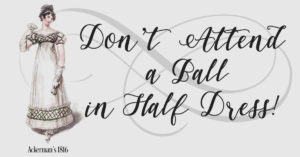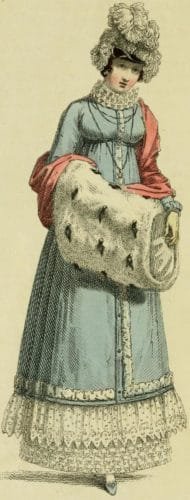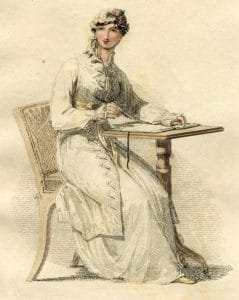Undress, Half Dress, Full dress? What’s a Girl to do?

Undress, Half Dress or Full Dress. What’s the difference and why did it matter?
This month the focus is all about the Netherfield Ball. And what are a young lady’s first thoughts about when invited to a ball? What to wear of course!
Not surprisingly, the sort of ball being held would determine appropriate dress for the evening. An event like the Meryton Assembly, a public ball, might only call for ‘half dress’, nice by not terribly formal. On the other hand, a private ball like the Netherfield Ball, one expected to be the event of the season and quite possibly the whole year, called for formal, full dress.
But what exactly do the terms mean? Half dress, obviously doesn’t mean wearing only half the necessary clothing, or short clothing, just like full dress doesn’t mean wearing all the necessary pieces of clothing. Similarly, undress did not mean, well just what it sounds like. (Although the notion is pretty humorous if you give it a thought or two.) Someone in undress actually was wearing a good deal of clothing! So what does it all mean?
Regency Era Categories of Dress

Ackermann’s Repository, 1817 Can you guess what sort of dress this would be?
In the most technical sense, there were two main categories for Regency Era clothing, undress and full dress. Undress referred to pretty much anything that was not full dress—rather handy, that. So anything worn during a non-formal even qualifies as undress.
That mean the following garments technically fall under the category ‘undress’:
- Morning dress
- Walking-out dress
- Carriage dress
- Promenade dress
- Afternoon dress
- Riding Habit
- Half-dress
If there were only two categories, what does ‘half dress’ mean? It functioned as a sort of catch-all category for garments more formal than every day ‘comfy clothes’ and less formal than ‘white tie.’ Think of it as the Regency equivalent of a suit and tie. It could include informal evening wear like dinner dress and opera dress; sometimes afternoon and promenade dresses fell into this category, too, depending on how ‘fancy’ they were.
How to tell Undress from Full Dress

Ackermann’s Repository 1808 Full dress on the left; walking dress on the right.
Naturally fabrics and embellishments constituted major differences between undress and full dress. Silks, fine muslins and the like were found in formal wear, but not in daytime garments. Difference could also be found in the general shape of the garments.
Evening wear featured a lower (and in some years MUCH lower) bodice and often short sleeves. Skirts with heavy embellishments and long or short trains were also typical of full dress gowns. Evening accessories often included long gloves (to make up for the short sleeves, of course), fancy headdresses (as opposed to hats and bonnets) fans, jewelry, and delicate satin slippers not durable enough for outside wear.
Clothing made a (Wo)man
Theoretically, one wore Undress in the morning, Half-Dress in the afternoon, and Full Dress for (formal) evening events. If it sounds like a gentlewoman had to change clothes several times a day, you’d be right. To be active in society, a Regency era lady had to have the right garment for the right occasion, and that added up to a lot of gowns (and corresponding expense.)

Ackermann’s Repository, 1813 Morning Dress
Unfortunately wearing the wrong sort of gown at the wrong time could be a devastating social blunder. Ladies (and gentlemen) were judged by their dress. If you failed to dress properly, it was a sure statement about your fortune (or lack thereof) and your place in society. In a very real sense, a man or woman was often made by their appearance, for better or worse.
Thankfully for young women everywhere, there was a great deal of advice available on how to dress appropriately. Our next installment will look at the advice offered by ‘A Lady of Distinction’ in The Mirror of Graces (1811).

I can understand now why Lizzy was always taken shopping by Mrs. Gardiner, Lady Matlock, and Georgiana in order to prepare her for the Derbyshire winters and to solidify her place in society as Darcy’s wife. She was always aghast at what they said she needed and then they shocked her by ordering even more.
RAther staggering how much a woman of society needed to get by, isn’t it?
I had read some of these terms before (well, I’m not sure about “undress” ) and wondered about the exact meaning. Walking out dress vs promenade dress?? And carriage dress – why was it specific for carriages?
I had the thought that this is one of the difficulties in Regency time travel fanfiction. Even if a modern, erudite JA fan (knowledgeable about social rules and terms of address and types of food etc.) should time travel back, she could not possibly avoid horrible social blunders from dressing ingappropriately that are more than just humorous.
Another thought: how much of this elaborate dress code was known to a country gentleman’s daughter like Elizabeth Bennet (and how much was Mrs. Bennet’s lack of social background detrimental in this?) Was Miss Bingley’s disdain for lack of refinement in the country justified?
Actually a carriage dress was for walking–it referred to the way a woman carried herself when moving about. One of the little tidbits I learned researching this, but some how it didn’t make it into the final draft of the post.
Since fashion magazines circulated in the mail, young women would have the ability to know how they were expected to dress. The actual fabrics and trims through might take longer to get into the countryside. But then they’d be wearing ‘last years'” gown rather than something entirely inappropriate.
‘
Pingback:Fashion for a Sea-Bathing Holiday ~ Random Bits of Fascination